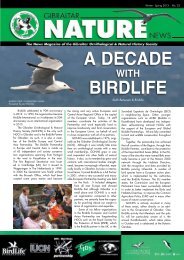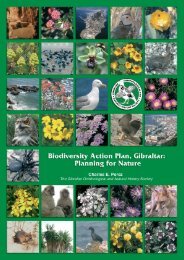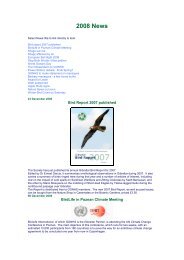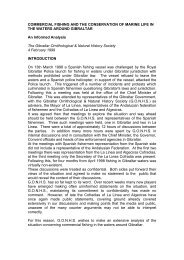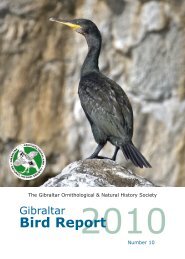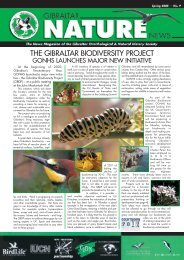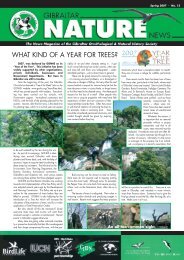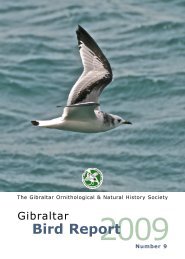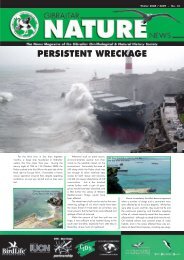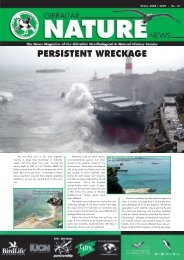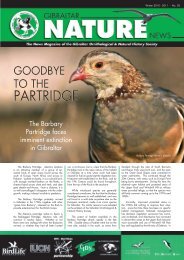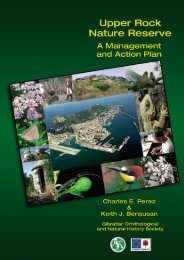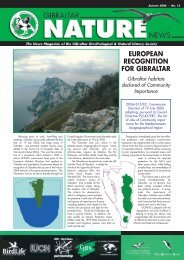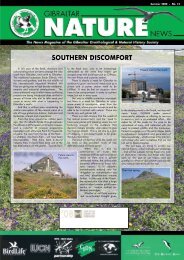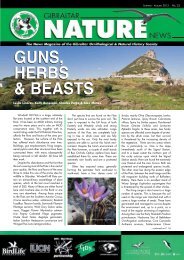2005 (No 5) - Gibraltar Ornithological & Natural History Society
2005 (No 5) - Gibraltar Ornithological & Natural History Society
2005 (No 5) - Gibraltar Ornithological & Natural History Society
You also want an ePaper? Increase the reach of your titles
YUMPU automatically turns print PDFs into web optimized ePapers that Google loves.
GONHS<br />
PROBABLE NESTING OF THE BLUE-CROWNED<br />
CONURE Aratinga acuticaudata IN GIBRALTAR<br />
John Cortes<br />
Strait of <strong>Gibraltar</strong> Bird Observatory, GONHS, PO Box 843, <strong>Gibraltar</strong>.<br />
Exotic bird species are regularly observed in <strong>Gibraltar</strong>, mostly attributable to<br />
escapes from captivity. Many of the species concerned are tropical and most of<br />
these are parrots Psittacidae. Several species of parrots have been recorded flying<br />
free in <strong>Gibraltar</strong>, including Senegal Parrots Poicephalus senegalus, African Grey<br />
Parrots Psittacus erythacus, Monk Parakeets Myiopsitta monachus and several<br />
conure species, including individual Blue-crowned Conures and White-eyed<br />
Conures Aratinga leucophthalmus. Colonies of Monk Parakeets, Ring-necked<br />
Parakeets Psittacula krameri and Nanday Parakeets Nandayus nenday are established<br />
in nearby Spain (Barros & Rios 2002), with this last species nesting in<br />
Sotogrande, Cádiz, approximately 10km north of <strong>Gibraltar</strong>. However there have<br />
been no conclusive records of any parrot nesting wild in <strong>Gibraltar</strong>.<br />
Free-flying parrots in <strong>Gibraltar</strong> have been seen largely to frequent garden<br />
areas, mainly in the South District, where the combined grounds of the Mount, the<br />
Botanic Gardens in the Alameda and other smaller areas cover approximately 18<br />
hectares. There are many broadleaf trees: especially Olive Olea europea, Nettle<br />
Tree Celtis australis, and Narrow-leaved Ash Fraxinus angustifolia, palms: largely<br />
Phoenix canariensis, and shrubs including Tecoma capensis, Lantana camara and<br />
Viburnum tinus. Since 1997, confiscated or rescued parrots of several species have<br />
been kept in captivity at the Botanic Gardens, adding to the attraction of the area<br />
for free-flying escapees, which frequently visit and interact with the captive parrots<br />
and perch on their cages or adjacent trees.<br />
Adult Blue-crowned Conure, Upper Rock, <strong>Gibraltar</strong> (E. Shaw)<br />
59



